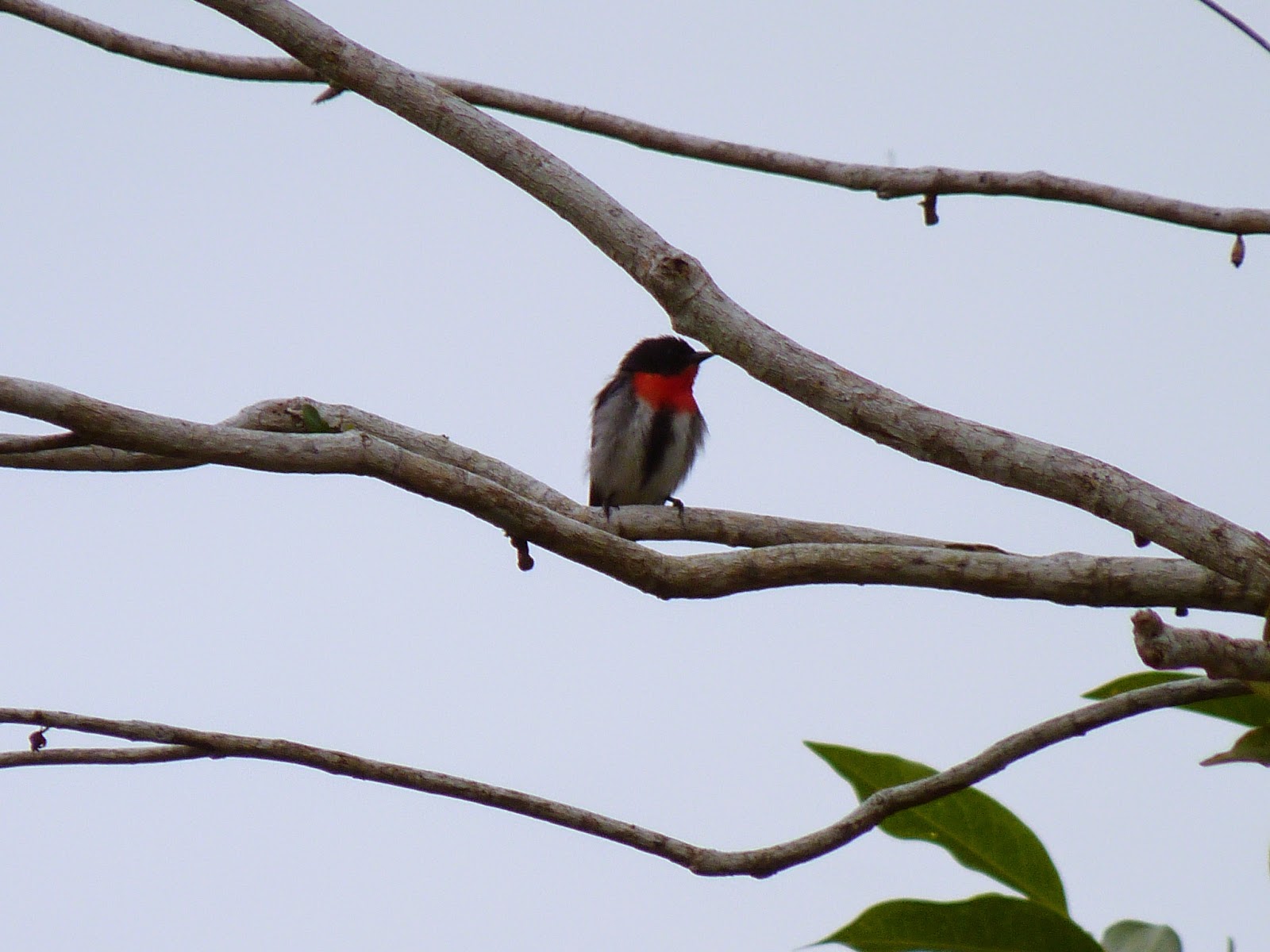The
Mistletoebird (Dicaeum hirundinaceum) is a species of flowerpecker native to
most of Australia (though absent from Tasmania and the driest desert areas),
and also to the eastern Maluku Islands of Indonesia in the Arafura Sea between
Australia and New Guinea. These shots however are not wonderful but they are all I ever obtained of this lovely little bird.
The Mistletoebird is small, 9–10 cm long and 7.5–11 g weight. The male is glossy blue-black above, with a red chest and a slight red undertail, and a black centre stripe running down its white belly. The female is dark grey above, with a white throat, light grey underparts, and just a touch of pinkish-red under the tail. The eyes, bill and legs are black; the bill is just over a centimetre long, slender, slightly down curved and sharply pointed. Immature birds are similar to the female, but have an orange-pink bill instead of black.
The Mistletoebird eats a variety of different foods. It
commonly eats the berries of mistletoes (hence the name) and other plants. The
diet also includes nectar, pollen, spiders, and insects.
They also must live where there a.re trees and shrubs, so that they can build their nests. I added the shot below to show you the chicks (not mine)
The female Mistletoebird builds the nest by herself with no help from the male. The nest is made of crushed plants and spider webs, which holds it together and holds it to the tree. She will lay three or four white eggs in the nest and look after them till they hatch. When they have hatched both parents will feed them.
By eating the fruit of the parasitic mistletoe, this bird is able to spread the seeds. When the birds eat the berries, the seeds pass through them, which takes anywhere from 4–25 minutes. Then when the birds excrete the seeds, they are sticky and easily adhere to the branch or trunk of a tree where they soon sprout.
I am linking this post with WILD BIRD WEDNESDAY.
I hope you enjoyed seeing this lovely looking bird and I thank you for visiting my post today.
Many thanks for leaving comments on any of my posts.





Hi Margaret, no I didn't see the Darter with his neck extended or in the water either, unfortunately. I love the shots of the chicks, the Mistletoe bird looks beautiful too. Thanks for sharing such interesting facts and great photo's about this bird.
ReplyDeleteHi Karen Keep looking out for the Darter in the water, it is so different. Glad you liked this Mistletoebird and many thanks for visiting and leaving a comment.
Deletethis is one of my favourite little birds Margaret and I love the little babes'
ReplyDeleteYes Carole, I love this little bird also. Thanks for visit & comment.
ReplyDeleteHi Margaret!
ReplyDeleteA lovely bird, which I haven't seen before! Nice photos and such cute little babies watching out of their nest! :)
Thanks for your visit and comment! /Pia
The fourth picture is worthy of Museum, it is simply beautiful. Thank you for showing us these photos that increase our internal joy.
ReplyDeleteTomás.
They are a very hard bird to get a picture of - my trip to central Australia yielded some nicely sharp pictures of the branches where they used to be, and little else! Well done.
ReplyDeleteCheers - Stewart M - Melbourne
Very interesting and informative post. At Quari National Monument in New Mexico we had the Phainopepla, a bird which is also associated with mistletoe and spreads it the same way and also by the seeds sticking to their feet. I was so disappointed when the arborists pruned out all the infected limbs of a stand of cottonwood and the birds disappeared.
ReplyDeleteGotta love this Margaret!!! And the trio of babies is so darling.
ReplyDeleteThank you for the interesting information and photos of this pretty little bird.
ReplyDeleteAnother new bird for me! It is beautiful.
ReplyDeletesuch a striking little thing!
ReplyDeleteWhat a little cutie! I like the red throat.
ReplyDeleteI've never seen or heard of this little bird, he sure is a pretty one! That's an excellent shot of the little ones waiting for food!
ReplyDeleteInteresting bird ,lovley shots ,nette
ReplyDeletePretty little bird. Thanks for sharing so much info about it!
ReplyDeleteWhat a pretty bird!
ReplyDeleteThis is similar to our Phainopepla in the desert with our mistletoe here. Really cool bird and great shot of the little ones hanging out of the nest. That's incredibly cool! It's a symbiotic relationship between plant and bird.
ReplyDeleteThat's quite the colourful little bird.
ReplyDeletePretty bird, I love the beautiful color around its neck! Great shots!
ReplyDeleteOh how cute and sweet! I was not aware of this little fella! He looks somewhat like a large hummingbird. And the babies, what a great picture!!! I think your photos are good, at least we can see his coloration and beak size.
ReplyDeleteI enjoyed reading about the process of how mistletoe spreads... hadn't realised before. Lovely shots of that little bird, they'd be quick little creatures. What a lot of work has gone into its nest too - it was good to see the added photo of that - plus those cute chicks :D)
ReplyDeleteAnother delightful post Margaret and this is such an interesting little bird. I don't usually have a favorite that I can choose amongst yours but that one with the baby birds is priceless. I just love it.
ReplyDeleteWho doesn't love a bird with a little red?
ReplyDeleteThat red throat sure sets off the otherwise neutral color. I'll never think of mistletoe again without thinking of this little beauty.
ReplyDeletelove the photo of the chicks! :-)
ReplyDelete